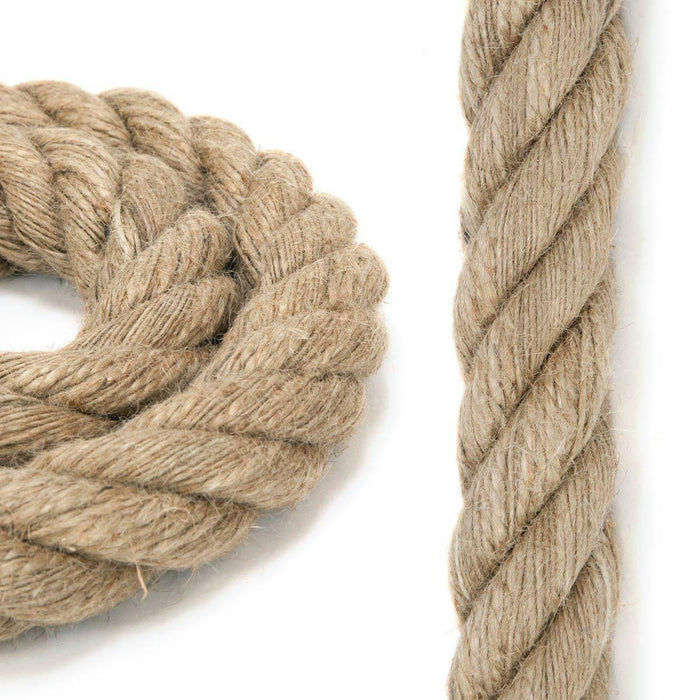
1 1/2" 4-Strand Jute
Weight: 0.44 lb

We just started stocking this unique product for customers who are seeking something a little different for interior decor use.
This is an honest to goodness 100% real jute rope. It is a little softer and more supple than manila rope. This is due to the longer cellulose plant fibers that go into making this type of rope.
We wouldn't recommend this rope for outdoor decor and/or landscaping (try the ProManila for that). Nor would we suggest this for exercise climbing. If you need some soft and supple large diameter brown rope for interior decor use then you should check this one out. It really does fit in that sweet spot of a nice organic brown rope without the typical firmness (or smell) of manila.
This is a FOUR STRAND rope as opposed to the three strand ropes (like manila or cotton).
Wherever possible, use splices constructed to safe specifications. A proper splice on a rope can maintain 80% to 100% of the new rope average break strength. Trained personnel should construct all splices. If knots are used on a rope, be aware that they can reduce the rope's strength by up to 50%. If knots are required, be sure to select the proper knot for the job.
All rope has a rating referred to as a "tensile strength" or "average break strength." This number is the amount of weight that the rope should be able to hold in ideal conditions, specifically, a new rope, with no knots or splices, at room temperature. These break strength numbers are based on actual destructive break testing by the manufacturer or a certified third-party testing facility. Ropes are tested over many cycles and the average break strength is determined and specified for the product. We test our ropes personally, and all our splicers have their work tested on an ongoing basis using a certified test bed facility. This is to ensure that their splicing work is perfect, and that their splicing technique and skills are 100% within acceptable splicing guidelines set by the rope industry. Even the best splices and best rope can break if overloaded or used improperly. Make sure you thoroughly understand what you are doing with a rope. Get the right rope for the right job. If you have questions or are even remotely unsure or have doubts. STOP and get the information you need to BE SURE you are doing things safely.
Rope wear, knots, extreme hot or cold temperatures, chemicals, the manner in which the load is applied and other factors will result in a break strength lower than the stated average break strength.
A rope with a stated or advertised break strength, in pounds will not necessarily safely hold something that weighs that amount! Refer to the SAFE WORKING LOAD of a specific rope for more information.
IF IN DOUBT, ASK A PROFESSIONAL. We get calls all the time from people who have questions about what is the best rope to use for any given application. Don't be afraid to ask. Ultimately YOU are responsible for your safety using ANY rope, so don't chance it.
In a broad generalization, most working loads vary from 1/10 to 1/4 of the average break strength of the rope. Applications for rope used in life support or personal fall protection environments must use the 1/10 ratio.
This is a FOUR STRAND rope as opposed to the three strand ropes (like manila or cotton).
Jute rope shrinks when it becomes wet. This effect can be advantageous under certain circumstances, but if it is not a wanted feature, this should be taken into account. If the rope will be used in an outdoor application, please consider ordering 10-15% additional product to accommodate shrinkage.